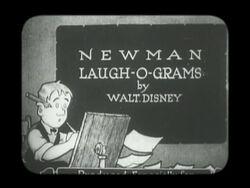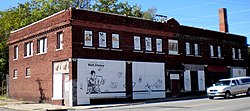Top Qs
Timeline
Chat
Perspective
Laugh-O-Gram Studio
Animation studio founded by Walt Disney From Wikipedia, the free encyclopedia
Remove ads
The Laugh-O-Gram Studio (also Laugh-O-Gram Films) was an Independent American animation studio founded by Walt Disney on June 28, 1921 and closed on October 16, 1923. It was located on the second floor of the McConahay Building in Kansas City, Missouri, as a key early venture for Disney and his recruited pioneers of animation, including Ub Iwerks, Hugh Harman, Rudolf Ising, and Friz Freleng.
The company was incorporated to produce a series of contracted animated shorts called Newman's Laugh-O-Grams. Disney was encouraged by their local popularity, and began producing his own series of modernized fairy tale cartoons, including Little Red Riding Hood. The studio secured a contract for six shorts with Pictorial Clubs, Inc., of Tennessee, but the distributor paid only a small advance before going bankrupt. The loss of income crippled Laugh-O-Gram financially, forcing Disney to live in the office and bathe weekly at Union Station. A final project, a dental hygiene film called Tommy Tucker's Tooth, funded Disney's production of Alice's Wonderland, which combines live-action and animation in a last resort to create a successful franchise.
The studio filed for bankruptcy in July 1923. Disney sold his camera and moved to Hollywood with an unfinished reel of Alice's Wonderland. The move proved successful, because he secured a distribution deal with Margaret Winkler, which led to the creation of the Alice Comedies series and the founding of the Disney Brothers Cartoon Studio, the predecessor to The Walt Disney Company.
Disney later recalled that the creation of Mickey Mouse was inspired at Laugh-o-Gram Studio, based on a tame mouse he kept at his desk there. The story of the studio has been depicted in two feature films, As Dreamers Do and Walt Before Mickey. The historic McConahay Building fell into disrepair, and a nonprofit organization, Thank You, Walt Disney, has been restoring it.
Remove ads
History
Summarize
Perspective
In 1921, Walt Disney was contracted by Milton Feld to animate twelve cartoons, which he called Newman's Laugh-O-Grams.[ChWDC 1] On May 23, 1922, when Disney was 20 years old, Laugh-O-Gram Films (LOGF) was incorporated by him using the remaining assets of the defunct Iwerks-Disney Commercial Artists from local investors. LOGF produced nine of the requested 12 films with little income.[ChWDC 2] Encouraged and inspired by his shorts' popularity at the theatre, Disney decided he wanted to make his own animated versions of fairy tales too, and invested six months on his first attempt at Little Red Riding Hood.[1]
Disney's employees on the series included several pioneers of animation: Ub Iwerks, Hugh Harman, Friz Freleng, and Carman Maxwell. The company had financial problems and by the end of 1922, Disney was living in the office and bathing weekly at Union Station.[2][3][4]
During the studio's sales manager Leslie Mace's stay in New York, where he was looking for distributors, he ended up signing a contract for six animated shorts with Pictorial Clubs, Inc. of Tennessee on Sunday, September 16, 1922. Pictorial agreed to pay US$11,000 (equivalent to $206,638 in 2024) for the cartoons, which were supposed to be shown at schools and other non-theatrical places, but only paid $100 in advance. The rest of the payment would have to wait until January 1, 1924, when all the shorts had been delivered. When Pictorial went bankrupt only a few months later, the studio never received the rest of the payment, its financial problems became even more serious, and the staff ended up leaving. When the local Kansas City dentist Thomas B. McCrum, from the Deener Dental Institute, contacted Disney and offered him the job of producing a short subject about dental hygiene intended for the Missouri school system,[5] he brought together some of his staff again and made Tommy Tucker's Tooth, which earned the studio $500. Instead of paying off his creditors, the money was invested in the live-action/animation demonstration film Alice's Wonderland, starring the youthful Virginia Davis. Disney had noted how popular the Out of the Inkwell series from the Fleischer Studios was, which had animated characters interacting with the real world. By reversing this gimmick and using a real-life character in a cartoon universe instead, he hoped for a hit. Virginia Davis's contract with Laugh-O-Gram was signed by her parents on April 23, 1923, with terms giving her 5% of the Alice's Wonderland film's receipts.[ChWDC 3] Looking for a distributor for Alice's Wonderland on May 14, Disney wrote to Margaret Winkler, a New York film distributor.[ChWDC 4]
After finishing the raw edits of Alice's Wonderland,[ChWDC 5] the studio filed for Chapter 11 bankruptcy in July 1923.[ChWDC 6] Disney finally made some money by shooting a film of a 6-month-old girl named Kathalee Viley[6] and selling his movie camera, earning enough for a one-way train ticket, moving to Hollywood, California; he brought along an unfinished reel of Alice's Wonderland.
The bankruptcy trustee was able to force LOGF's erstwhile distributor and debtor, Pictorial Films, Inc., to pay LOGF's agents the sum owed while agreeing that Pictorial could exercise its contractual distribution rights for LOGF works and to purchase several of LOGF's films: The Four Musicians of Bremen, Jack the Giant Killer, the Lafflets series, and Alice's Wonderland.[7]
The studio building fell to ruin and efforts were made to restore it by a non-profit group called "Thank You, Walt Disney". The Disney family promised $450,000 in matching funds for the rights to other Disney memorabilia and to tell the history of Walt Disney's life in Kansas City, a movie house to exhibit original and restored Laugh-O-Grams, and an education center for animation workshops.[8]
On July 30, 2021, a black Dodge Charger struck the building and caused significant damage to the exterior. The incident occurred early in the morning, the driver fleeing the scene, though authorities subsequently found a woman's driving license and a margarita within the vehicle. Butch Rigby, who launched the campaign to save and restore the building, described the incident optimistically: "The bottom line, it's a bump in the road, but it could have been worse".[9]
Remove ads
Inspiration for Mickey Mouse
Disney told interviewers that the inspiration to draw Mickey came from a tame mouse at his desk at Laugh-O-Gram Studio in Kansas City, Missouri.
They used to fight for little pieces of cheese in my waste-basket when I worked alone late at night. I lifted them out and kept them in wire cages on my desk. I grew particularly fond of one brown house mouse. He was a timid little guy. By tapping him on the nose with my pencil, I trained him to run inside a black circle I drew on my drawing board. When I left Kansas City to try my luck at Hollywood, I hated to leave him behind. So I carefully carried him to a backyard, making sure it was a nice neighborhood, and the tame little fellow scampered to freedom.[10]
In 1928 during a train trip to New York, he showed the drawing to his wife Lillian Marie Bounds and said he was going to call it "Mortimer Mouse". She replied that the name sounded "too pompous" and suggested Mickey Mouse instead.[10]
Remove ads
Filmography
Summarize
Perspective
Of the original seven Laugh-O-Grams fairy tales, four were long known to have survived, and have been restored for DVD: Newman Laugh-O-Grams (1921), Little Red Riding Hood (1922), The Four Musicians of Bremen (1922), Puss in Boots (1922), and Cinderella (1922). These shorts later became available on Blu-ray Disc as bonus features for Disney's Beauty and the Beast. Tommy Tucker's Tooth (1922) and Alice's Wonderland (1923) are also available on DVD, and Alice's Wonderland eventually became a bonus feature for the 60th Anniversary Blu-ray Edition of Alice in Wonderland. The original piece of filming and animation known as Newman Laugh-O-Grams (originally released theatrically on March 20, 1921)[11] is available on some DVDs too. In accordance with United States copyright law, all 11 shorts produced by the studio have entered into the public domain as of 2019.[12]
The missing fairy tale cartoons were Jack and the Beanstalk, Jack the Giant Killer, and Goldie Locks and the Three Bears (all 1922). In October 2010, copies of all three cartoons had been found according to animation historian David Gerstein.[13][14] For many years the two Jack cartoons were believed to be one, until researcher John Kenworthy located old studio assets sheets confirming that they were separate shorts.[15]
Remove ads
See also
References
External links
Wikiwand - on
Seamless Wikipedia browsing. On steroids.
Remove ads




